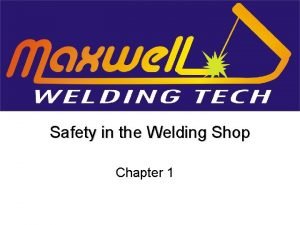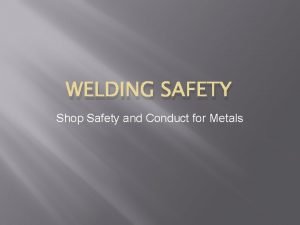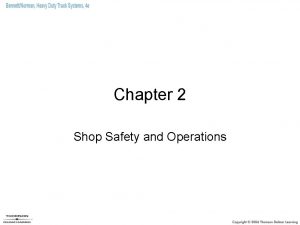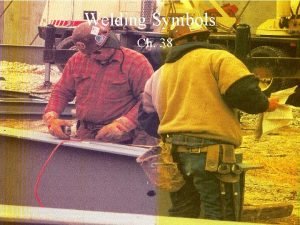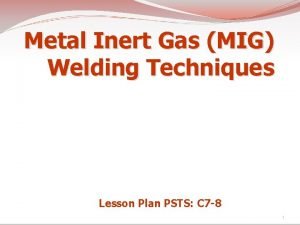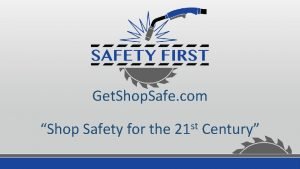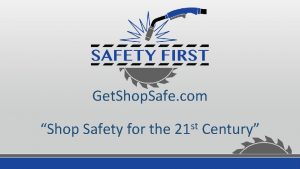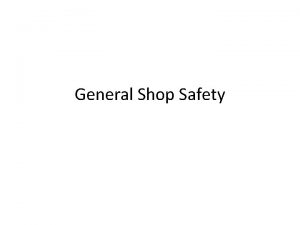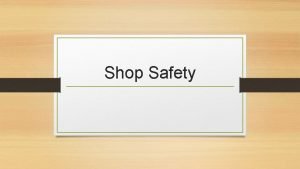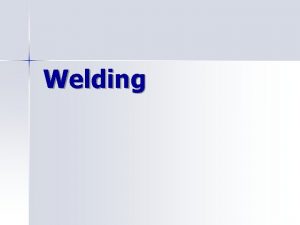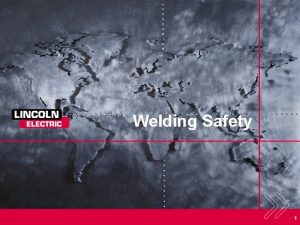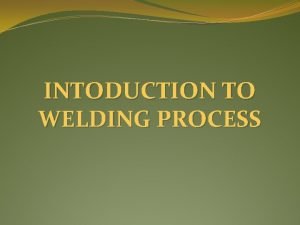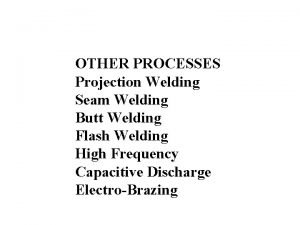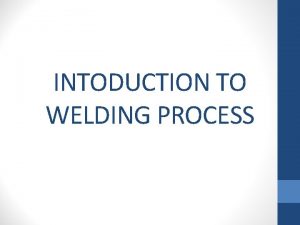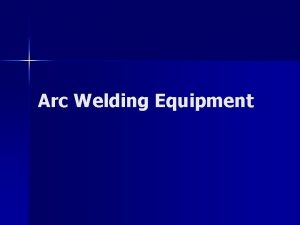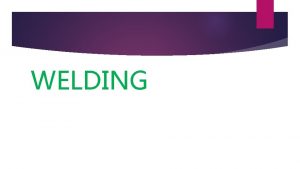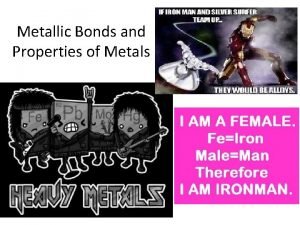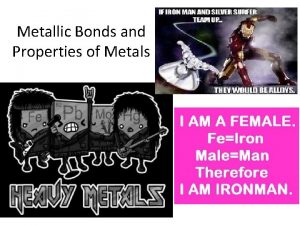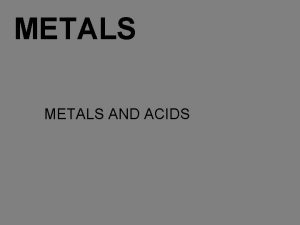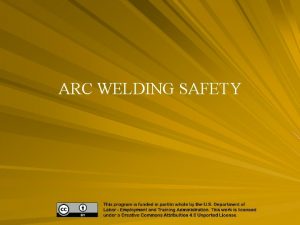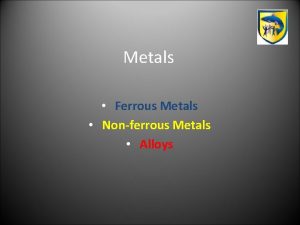WELDING SAFETY Shop Safety and Conduct for Metals


















- Slides: 18

WELDING SAFETY Shop Safety and Conduct for Metals

General Safety � � � Safety Test must be passed before any student is permitted to work in the shop. Ask instructor to approve all work that you plan to do. Keep tools and materials from projecting over the edge of benches whenever possible. Use a brush to clear away chips or slag and a rag to clean oily areas. Immediately wipe up any spilled liquids from the floor.

� � � Never attempt to lift heavy objects without assistance. Wear proper clothing while in the welding shop. Long cotton pants, long sleeve cotton or wool shirts, and high top leather boots are the best. Coveralls are good but make sure they are made from cotton. Synthetic, manmade materials, such as nylon, polyester, and corduroy should not be worn, they will not stop sparks or flames and they could melt onto your skin making burns more severe. Safety glasses must be worn at all times in the welding shop. If the noise level is too high, ask the instructor for ear plugs.

� � � Wear other personal protective equipment as needed by specific jobs. Wear gloves, aprons, and sleeves as needed. Do not hurry or rush. Trying to get too much done in a limited amount of time can produce unsafe work practices, which can endanger yourself and others. Notify the instructor immediately in case of accident, injury or fire. The instructor should be notified in the case of broken or defective tools and equipment so they can be taken out of service. The instructor must be aware of injuries so that proper first aid can be given. No Horseplay!! Chasing, scuffling, pushing etc is dangerous to yourself and others. Always remember that there are hot, sharp, hard, and dangerous equipment in this shop. Clean up after yourself. Clean your work area and return all tools and equipment to their proper place, then do your assigned cleanup.

� � � Never leave the welding shop without the instructor's knowledge and permission--you will be marked truant. Be alert and think each action through before it is performed. If you have any doubt about how to operate a tool or machine, check with the instructor before proceeding. Never use power equipment that has not been demonstrated to you. Never use power equipment until you have passed a written safety test. Never use equipment until you have had a hands-on performance test. Never watch someone arc welding without the proper protective eye wear (shade 10). Welding produces ultraviolet light that can harm your vision. Tuck it in, take it off or tie it back. Baggy clothes and jewelry can catch on sharp corners and be pulled into equipment, long hair and frayed clothing can catch on fire from sparks and flames.

� � � Never attempt to work with tools or equipment while under the influence of drugs or alcohol. This includes prescription or over the counter medication that may impair your abilities. Minor 1 st and 2 nd degree burns are best treated by holding the burn under cold water. Show all burns to your instructor. Do not stand on the brooms. You will lose points, and the brooms could be damaged. No Graffiti! Anyone grinding, painting, scratching, drawing or welding anything onto any surface will be punished. Do not spray others with compressed air. Compressed air could cause injuries if used improperly.

� Fire extinguishers are located throughout the building. � � � � Class A: flammable solids, wood, paper. Class B: flammable liquids, gas, oil. Class C: electrical fires, motors, fuse boxes. Class D: combustible metals zinc, magnesium. Do not hammer directly on the anvil without something in between. Both the hammer and the anvil are made of hardened steel which could shatter. Assume all electricity is dangerous. Only trained technicians should do repairs on electrical equipment. Make sure power tools are unplugged before checking for loose connections or worn insulation. Good ventilation is important. Fumes from welding and cutting can be harmful to your health. Metal coatings such as paint and galvanized metal can give off toxic fumes when heated.

Plasma Cutter � � � Never handle plasma cutter with oily or greasy hands or gloves. Never lay a lighted torch down. Safety caps should be on when not in use or moved. Always have cylinders chained and in a vertical position. Never carry anything combustible in your pockets.

Bar Shear � � � The minimum length of metal to be sheared is 4 Inches. The maximum thickness that can be sheared and bent is 16 gauge. Never shear more than one piece of metal at a time.

Handheld Grinder � � � � Make sure you do not have loose clothing, hair, or jewelry that could get caught in grinder. Always wear gloves when grinding. Keep hands or fingers away from grinding wheel. Do not use grinder without the proper guards in place. (Do not remove them) Make sure your work is clamped down when grinding. Always have safety glasses and/ or face shield on while grinding. Make sure power is in the "off' position before turning on grinder

Pedestal Grinder � � � � Always use a face shield or goggles when operating a grinder. Keep fingers free of the wheel when grinding. After a new wheel has been installed, you should stand to one side, turn it on, and let it run for at least a minute before starting to grind. You should wash your hands thoroughly before touching your face or eyes after using a grinder. You are responsible for the safety of others nearby when you are using any grinder. If anything seems wrong with a grinder, turn it off, and call your instructor. Guard should be adjusted to 1/8" to wheel before power is turned on.

Chop Saw � � � � In making a cut on the saw the stock must be held solidly against the fence with the clamp. The saw should not be forced into the material any faster than it can cut with ease. The hands should be kept to one side of the direction of the saw cut in the event the saw stalls because of overfeeding. Only one piece at a time should be cut on the saw. Always give the saw blade clearance and let it reach proper momentum before pulling blade into stock being cut. Never use saw without a properly adjusted safety guard. For special operations, make sure that stock is supported by stops or clamps.

Drill Press � � � Insert the drill in the chuck properly and tighten it securely before starting the drill press. Remove the chuck key before power is turned on. Use a base block under work or be sure drill is over center hole in table when boring completely through stock. All work must be securely clamped to table or held firmly in drill vise. Make a center punch mark in which to start the drill. Always ease up on the drill as it is about to go through the bottom of the stock.

Arc Welding � � � Welding rays are dangerous so precautions should be taken The cylinder valve in GMAW must be protected when moving. The fumes in GMAW cannot always be smelled. You should check for gas leaks using soapy water. You should check all cables for breakage and/ or wear before operating machine.

� � � Protective clothing including: leather gloves, welding hood, long sleeves, safety glasses, and leather boots should be worn while welding. There is a risk of electrical shock when welding. Welding should be done in booths or behind curtains. Leather clothing is best when arc welding. Carbon dioxide/monoxide can be generated while arc welding. Never strike an arc without an approved arc welding helmet over your face and eyes.

� � � Warn others around you before you strike on arc. Do not weld on or near combustibles such as gas and oil. Make sure safety glasses are worn, even under the welding hood or while chipping slag. Do not weld bare handed. Cool all hot pieces of metal or place them where others will not come in to accidental contact with them. Label hot metal HOT!

� � � Keep your machine and person dry at all times. Face, hands, arms, and other skin surfaces must be covered. Remove anything flammable or valuable from person. i. e. : lighter, cell phone, i. Pod. Take extra caution while welding painted and/ or galvanized metal that you are in a well ventilated area. Report all burns to instructor immediately.

Gas Metal Arc Welding � � � Check nozzle for spatter build up before welding. The pressure regulator on the shielding gas should be set in the range of 5 -30 PSI. Gloves need to be worn because of the very high heat output. There is a risk of electrical shock because of the low voltage used in GMAW. All welding should be done in a well ventilated area.
 Welding shop safety vocabulary
Welding shop safety vocabulary Welding shop safety
Welding shop safety Chapter 1 safety in the welding shop
Chapter 1 safety in the welding shop Periodic table with metals and nonmetals
Periodic table with metals and nonmetals Characteristics of metals
Characteristics of metals Natural science grade 5
Natural science grade 5 Grade 9 natural science term 2 notes
Grade 9 natural science term 2 notes Examples of metals
Examples of metals Periodic table metals nonmetals and metalloids color
Periodic table metals nonmetals and metalloids color Job shop organization
Job shop organization Ferrous metals vs non ferrous metals
Ferrous metals vs non ferrous metals Weld all around
Weld all around Chapter 3 review joint design and welding terms
Chapter 3 review joint design and welding terms Welding lesson plans
Welding lesson plans Getshopesafe
Getshopesafe Get shop safe
Get shop safe General shop safety
General shop safety Ag shop safety
Ag shop safety General shop safety
General shop safety
